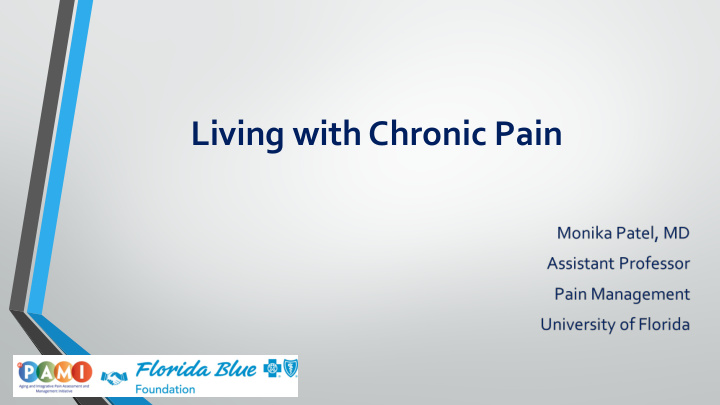



Living with Chronic Pain
Title: Presentation Information • Developed by Monika Patel, MD. • Funding provided by Florida Blue Foundation and the Florida Medical Malpractice Joint Underwriting Association. • Visit pami.emergency.med.jax.ufl.edu to learn more.
Agenda • Common Pain Conditions • Multimodal Treatment • Prevention of Adverse Events • Available resources
Chronic Pain is ongoing pain for several months to years
How Does Pain Affect Us? • Pain is multidimensional , affecting people Demographics physically, psychologically, socially and spiritually. Cognitive • Patients’ responses to pain may be related to: Clinical Cognitive Clinical Functioning Functioning • genetics, age, gender , ethnicity, socioeconomic and psychiatric factors, catastrophizing, culture, religion, Pain previous experiences, patient perceptions and expectations, etc. Genetics Religion Religion Genetics Psycho- Culture social 5
My Friend Arthr?
Osteoarthritis • Wear and Tear of the Joints • Thinning of the cushioning between the joint • Inflammation
Osteoarthritis Joint Pain • Knee osteoarthritis • Hip osteoarthritis • Shoulder impingement
“Arthr” in the spine • Facet Arthropathy, Spondylosis, Osteoarthritis • Block the pain signal from the joint
My Back Gave Out! Image by LillyCantabile from Pixabay
Disc Degeneration • Jelly in the Doughnut has dried or squeezed out • Common in the neck and lower back • Can have associate arm or leg pain
Epidural Injection • Bathes the nerve with anti-inflammatory medication • Provide short to long term relief
Broken Bone • Vertebral Compression Fracture • Hip Fracture • Wrist Fracture • Ankle Fracture
Muscle Strain • Pulled muscle • Lifting or carrying objects • Trigger Point Injections strengtheory.com www.allbackedtogether.com
Tendonitis • Over use injuries • Dequervain’sTenosynovitis • Medial and lateral epicondylitis www.robertsonfamilychiro.com
Phantom Pain and Neuroma • Amputations due to limb circulation problems or infection • Traumatic amputation with heavy machinery or car accident • Phantom pain- residual limb painful feeling • Neuroma- painful nerve bundle at the distal end
Nerve Injuries • Post surgery • Crush or minor injury • Complex regional pain syndrome www.practicalpainmanagement.com www.preferredpaincenter.com
Nerve Injuries • Peripheral nerve injuries –stocking or glove distribution • Ilioinguinal nerve- groin pain • Trigeminal nerve- facial pain
Multimodal Care • Medications • Lifestyle changes to reduce tension and stress • Use Ice or Heat • Get Exercise • Proper Nutrition • Healthy Body Weight • Adequate Sleep • Yoga • Meditation
Pain Management Specialists • Comprehensive approach • Evaluation of imaging, mechanism of injury, prior treatments • Interventional techniques • Collaboration with PT /OT and occupational therapies • Medications including adjuvant treatments • Pain Palliation modalities
PREVENTION
Short Acting Opioids • Codeine • Tramadol • Tapentadol • Hydrocodone • Oxycodone Long Acting Opioids • Morphine • Buprenorphine • Hydromorphone • Fentanyl • Morphine ER • Oxycodone ER • Methadone
• Sleepiness or confusion • Bad dreams or hallucinations • Constipation • Sweating Contact your • Nausea/vomiting • Itching Doctor • Dry mouth Immediately! • Increased risk of falls • Opioid dependence/addiction • Respiratory depression • Overdose leading to death
Naloxone Nasal Spray • Educate yourself and loved ones on use in Emergencies • Available by prescription • Available at your local drug store over the counter • Life Saving • Works for 10-15 minutes, allows time for rescue to arrive
Fall Prevention FLOORS: • Remove loose rugs • Slip free mats VISION: • Remove cord or wires in common • Improve lighting walking areas • Eye Glasses • Repair uneven floors • Mindful of wet floors • BALANCE: • Don’t over reach STAIRS: • Use a cane or walker • Repair loose steps • Wheelchair for long distance • Ensure strong hand rails • Core strengthening exercises BATHROOM: • Handrails in the bath tub • Sitting shower chair • Slip free mats
References Rathmell, James P. Atlas of Image-Guided Intervention in Regional Anesthesia and Pain Medicine: Edition 2. Lippincott Williams and Wilkins. 2012. Benzon, Honorio Raja, Srinivasa. Fishman, Scorr. Liu, Spencer. Cohen, Steven. Essentials of Pain Medicine: Edition 3. Elsevier Health Sciences. 2011. Raj, Prithvi. Lou, Leland. Walman, Steve. Staats, Peter. Radiographic Imaging for Regional Anesthesia and Pain Management. Churchill Livingstone. 2002 PAMI Educational Videos: http://pami.emergency.med.jax.ufl.edu/resources/pami-educational-pain- videos/
Recommend
More recommend